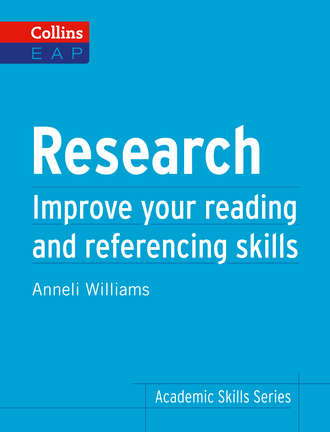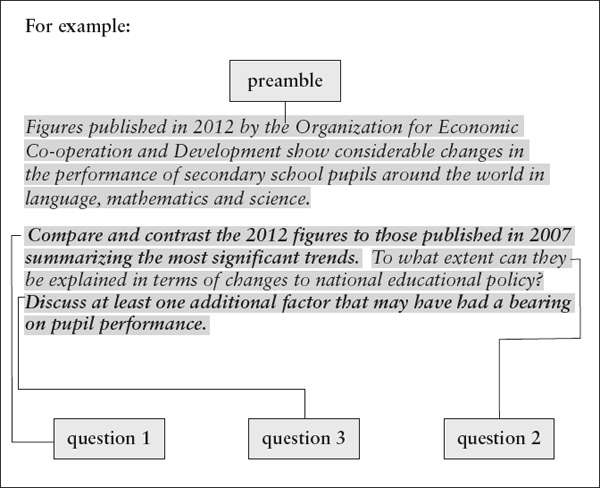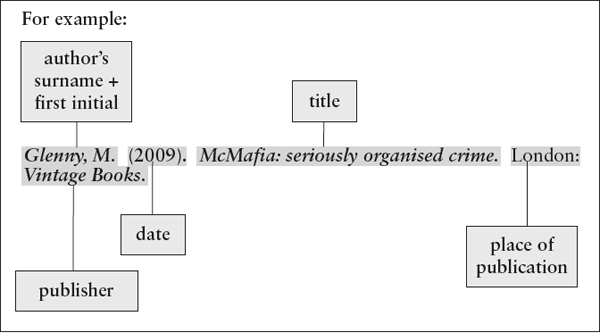
Полная версия
Research: B2+
2 Which definitely require you to give your opinion?
3 Which instruction word is most common?
Note that the answers given in the answer key are suggestions only. In practice, you should interpret each assignment task in the context in which it has been set. Remember that certain instruction words, for example, ‘compare and contrast’, sometimes require a more descriptive response and sometimes a more evaluative response.
For example: Compare and contrast horizontal axis design wind turbines and vertical axis design wind turbines.
This instruction requires a straightforward description of the similarities and differences between two types of wind turbine.
For example: Compare and contrast electricity generation from wind power versus electricity generation from hydropower in terms of efficiency, value for money and environmental impact.
Here you have to describe the similarities and differences between two forms of electricity generation in order to make judgements about them.
Understanding long and complex essay assignments
Sometimes essay assignments can be wordy and complex. However, these too can be broken down into parts:
Glossary
preamble A preamble is an introduction that comes before something you say or write.
1 The preamble: background information about the context of the question.
2 The question (or questions): what you need to find out.

The preamble gives you important information about the topic and its limitations. Notice that you need to focus your discussion on secondary school pupils (not primary school pupils or university students) and their performance in three subjects: language, mathematics and science.
Note that there are several questions that need to be answered.
Question 1 requires you to describe similarities and differences and to analyse the two sets of figures in order to identify the most significant trends.
Question 2 requires you to evaluate the evidence that the trends you have identified were caused by changes to national educational policy. Here you need to present an argument.
Question 3 requires you to consider at least one other possible explanation for the trends you have identified. Here too you need to present an argument.
Tips




Writing your own essay question
Sometimes you may be asked to write you own essay question. This is more likely to be the case towards the end of your course when you have had some experience of writing research essays. To write an essay question you can follow steps which are similar to those involved in interpreting a set essay question. Select:
1 The topic: the general area you want to investigate.
2 The focus: what you want to find out about the topic.
3 The approach: how you are going to investigate it.
Choosing a topic
You will probably spend a lot of time and effort on your research, so it is important to pick a topic that interests you. However, your topic should also be relevant to your course. You need to use your essay assignment to demonstrate that you can think more deeply about an issue covered in your lectures and/or reading.
If you have difficulty identifying a suitable topic, try looking at your course outline and lecture notes. List the topics that are most interesting to you and that seemed important to your lecturers. Put your list away for a time. When you come back to it, see what grabs your attention most.
Narrowing the topic down
Once you have chosen a topic, you need to narrow it down until you have a focus. If you write about a topic without first identifying your focus, you will probably end up conveying a lot of information without examining it in any depth.
Glossary
impact The impact that something has on a situation, process, or person is a sudden and powerful effect that it has on them.
Before you start your research, you need to think about what aspect of the topic is most interesting to you. For example, if you want to write about the topic of the internet, you may decide to focus on: the impact of the internet on how people relate to others.
This is a good start, but the topic is still rather broad. One method for narrowing your topic further is to highlight the key words and list specific words under those categories:
For example: the impact of the internet on how people relate to others
Under internet you might list: online gaming, social networking, or access to information.
Under people: children between six and ten, adolescents, young men from disadvantaged backgrounds, people who spend more than five hours per day online, etc.
Under relate to others: form friendships, maintain face-to-face social networks, perceive authority figures, see themselves in relation to others, etc.
This method can generate more than one focus from which to choose:
For example: the impact of online social networking on how adolescents form friendships. or: the impact of online gaming on how children between six and ten see themselves in relation to others.However, make sure that you do not narrow your question down too much. If your focus is too narrow, you may not be able to find enough information to research it properly.

Imagine that you are interested in researching why some films become very successful .
Narrow down the highlighted key words.
1 What type of films could you focus on?
2 What are the different ways you could define ‘successful’?
Choosing an approach
Once you have identified your focus, you need to decide on your approach, that is, how you are going to investigate it. To do this, it is helpful to rewrite your focus as a question. Sometimes there are several possible questions. The type of question that you ask will determine your approach.
For example, you could write the phrase: the impact of online social networking on how adolescents form friendships as the question: Does online social networking affect how adolescents form friendships?
Glossary
notion A notion is an idea or belief about something.
This question requires you to present an argument. You need to evaluate the evidence for the notion that online social networking has an effect as well as the evidence against and come to your own conclusion.
Alternatively, you could rewrite the question as: How does online social networking affect the way adolescents form friendships?
This question assumes that there is an effect. Your task is to analyse and explain that effect.
When deciding your approach, it is helpful to consider the context of your assignment. Discuss your title with people who are familiar with your course. Do some preliminary reading to find out what sorts of questions other scholars are asking about the topic.
You may also find it useful to break your focus down into several related questions:
For example: Does online gaming affect the way children see themselves in relation to others?
If so, to what extent does online gaming affect …
In what ways does online gaming affect …

Write an essay question of your own following steps 1–4 below.
1 Choose a general topic that interests you.
2 Identify your focus – write down what aspect of the topic interests you most.
3 Narrow down the topic by replacing very general words with more specific words.
4 Rewrite your focus as a question.
Remember








2

Aims






Quiz
Self-evaluation
What do you think is the most useful way to find information for an essay? Rate the activities below from 1 = least useful to 4 = most useful.
1 Go to your university library. agree | disagree | not sure 2 Surf the internet using a search engine such as Google™. agree | disagree | not sure 3 Look through your course reading list and handouts. agree | disagree | not sure 4 Use an academic database. agree | disagree | not sureStarting with what you already have
Before looking for information of your own, it is useful to think about what you already know about the topic. Make some notes of your ideas and any key information you have learned.
Then look at what information you already have about the topic from your course. Check your course reading list. If you have been told to read a ‘prescribed’ or ‘recommended’ book for your course, you may find it helpful to read or re-read any sections related to your essay topic. Check the references at the end for other articles or books that might be relevant to your topic. Highlight or make a list of the texts you want to find. Do the same for any photocopied course readings you have been given for your course. Finally, look through your lecture handouts and notes for any references to readings that are related to your topic. Add these to your list. Because these references have been recommended for your course, they are likely to be of good quality and suitably academic.
For more information on choosing suitably academic material, see Chapter 3.
Finding information in the library
You may be able to find some of the items on your list on the internet. However, you are more likely to find them in your library, either in paper or electronic form. When you have been set an essay topic, it is important that you go to the library as soon as possible as you will be competing for paper-based reading materials with other students on your course.
Most British and American university libraries are ‘open-access’, that is, users can access the shelves directly. Finding your way around the library can take a little time, so it is a good idea to get to know your library as quickly as you can. University libraries differ from place to place, however, most will work in a similar way.
Library catalogues
The first step is to familiarize yourself with the library catalogue. A library catalogue is a list of all of the materials in the library. You can access the catalogue online in the library and sometimes outside the library through the internet and/or intranet. The library catalogue will list a wide variety of materials: books, e-books, journals, e-journals, newspapers, doctoral theses and so on. For most essays assignments, you will need to access books and journal articles.
Glossary
intranet An intranet is a network of computers, similar to the internet, within a particular company or organization.
Before searching for the items on your list, make sure you know what sort of texts you are looking for. In reading lists and bibliographies, books will normally be listed under the author’s name and will usually include the date of publication, the title, the place of publication and the name of the publisher.

A chapter or article within a book will normally be listed under the name of the writer of the chapter and will include the title of chapter as well as the name of the editor of the book and the title of the book, the place of publication and so on.
Glossary
editor An editor is a person who collects pieces of writing by different authors and prepares them for publication in a book or series of books.
volume A volume is a collection of several issues of a journal, for example all the issues for one year.
access If you access something, you succeed in finding it or obtaining it.
An article in a journal will normally be listed under the name of the author of the article and will usually include the title of the article, the name of the journal, the volume number, the issue number, and the page numbers of the article.

An online article will also normally be listed under the author’s name and will include the URL of the item as well as a date for when it was accessed.

Imagine you have items 1–4 on your reading list. Match each item with the type of text a–d.
1 Bialystok, E. (2009). Bilingualism: The good, the bad, and the indifferent. Bilingualism: Language and Cognition, 12(1), 3–11. a a book 2 Grosjean, F. (1982). Life with two languages. An introduction to bilingualism. Cambridge, MA: Harvard University Press. b a chapter within a book 3 Simonton, D. K. (2008). Bilingualism and creativity. In J. Altarriba & R. R. Heredia (eds.), An introduction to bilingualism: Principles and processes (pp. 147–166). Mahwah, NJ: Lawrence Erlbaum. c a journal article 4 Tucker, G. R. (1999). A Global Perspective on Bilingualism and Bilingual Education. Center for Applied Linguistics. Retrieved August 10, 2012 from http://www.cal.org/resources/digest/digestglobal.html. d an article from the internetSearching for books by title and author
You can normally search the library catalogue for books by title, author or key words. If you know the item that you are looking for, it is easiest to use the author, or even better, the title. If you are looking for a chapter within a book, make sure that you type in the title of the book, not the title of the chapter. For example, for item 3 in Exercise 1, type An introduction to bilingualism: Principles and processes into the search box.
Glossary
recall If a library recalls a book, it asks the person who has borrowed it to return it.
The catalogue will show you whether the book is available and where you can find it. Sometimes several books with the same title will be listed. This may be because several editions of the book are available or because the library holds both a print and electronic version of the book. For print books, select the book you want and make a note of the location and any identification code given to the book by the library. This might be referred to as a ‘call number’, ‘shelf-mark’ or similar term. This code will give you information about the section of the library where the book is located.
If the catalogue indicates that the book is ‘on loan’ you may be able to recall it, either electronically or by requesting this service at your library help desk.
Searching for journals by title
If you are looking for a journal article and you know the name of the journal, you need to search using the title of the journal, not the title of the article. For example, for item 1 in Exercise 1, you should type Bilingualism: Language and Cognition into the search box. Journals are listed in the catalogue chronologically (with the most recent appearing at the top of the list), so it is important to know when the issue that you are looking for was published. Like books, journals may also be available in both print and electronic forms. To find the print version of a journal, note the location information. The most recent issues of print journals are normally shelved separately from older issues. Older issues of a journal are often collected together in ‘volumes’. Like books, these are labelled with a call number or shelf-mark so that you can retrieve them easily.

Imagine you wanted to search your university library catalogue for the items below. For each item, indicate the type of publication and the words you would use to search.
1 Small, G., & Vorgan, G. (2008). iBrain: surviving the technological alteration of the modern mind. New York: Collins Living.
2 Semanza, J. C. (2003). The Intersection of Urban Planning, Art, and Public Health: The Sunnyside Piazza. American Journal of Public Health, 93(9), 1439–1441.
3 Inceoglu, I., Segers, J., & Bartram, D. (2012). Age-related differences in work motivation. Journal of Occupational & Organizational Psychology, 85(2), 300–329.
4 Chan, K. W., Kwong, C. K., & Dillon, T. S. (2012). Computational intelligence techniques for new product design. New York: Springer.
Type of publication Search terms 1 2 3 4



